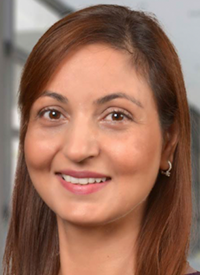Article
Panelists Parse Out Answers to Key Questions in Hematologic Malignancies
Author(s):
Stephen A. Strickland, MD, BS, MS, MSCI, relays insightful questions from the audience to the speakers, who provided insight into how they are navigating the evolving treatment landscape of hematologic malignancies.
Stephen A. Strickland, MD, BS, MS, MSCI

During the 2020 Institutional Perspective in Cancer (IPC) webinar on hematologic malignancies, Stephen A. Strickland, MD, BS, MS, MSCI, Hematology Clinical Service Line Chief, assistant professor of medicine within the Division of Hematology/Oncology, and clinical director of Acute Leukemia at Vanderbilt University Medical Center, moderated a panel discussion on common clinical scenarios in Hodgkin lymphoma, peripheral T-cell lymphoma (PTCL), and chronic lymphocytic leukemia (CLL) and the considerations that should be made for optimal treatment selection.
Strickland was joined by 4 panelists:
- David S. Morgan, MD, BA, associate professor of medicine, Vanderbilt Health
- Nishitha M. Reddy, MBBS, associate professor of medicine, director of the Lymphoma Program, Vanderbilt University Medical Center
- Seema A. Bhat, MD, assistant professor in the Department of Internal Medicine, Division of Hematology, The Ohio State University Comprehensive Cancer Center–James
- Olalekan O. Oluwole, MBBS, MD, assistant professor of medicine, Hematology/Oncology, Vanderbilt Institute for Infection, Immunology, and Inflammation
Additionally, the panel shed light on the growing role of CAR T-cell therapy as a treatment for patients with leukemia and lymphoma.
During the question-and-answer portion of the virtual IPC meeting, Strickland relayed insightful questions from the audience to the speakers, who provided insight into how they are navigating the evolving treatment landscape of hematologic malignancies.
Strickland: Dr. Morgan, does the age of a patient with classical Hodgkin lymphoma [cHL] affect how you treat them? Would you be more apt to consider the ECHELON trial data and give a patient brentuximab vedotin [Adcetris] based on age as opposed to bleomycin?
David S. Morgan, MD, BA

Morgan: A number of studies are exploring that question of using brentuximab vedotin and/or nivolumab [Opdivo] as frontline therapies. Personally, if a patient has good pulmonary function, I treat them as [I do] everyone else. I would need to see a really good pulmonary function test in a very old person in order to give them ABVD [doxorubicin, bleomycin, vinblastine, and dacarbazine].
Strickland: To follow that up, what if you have an older patient who [does not have] advanced stage cHL and fits the criteria [for brentuximab vedotin], but has compromised lung function? How do you handle those patients, young or old, with compromised lung function? Would you give that patient brentuximab vedotin even though it is not consistent with the trial parameters?
Morgan: It is important to note that we don’t have approval for, or any data [regarding the use of brentuximab vedotin] in earlier-stage [disease]. [However, in my practice] we did that recently for a young patient who had just had COVID-19 [coronavirus disease 2019], very compromised lung function, and [bulky stage II] Hodgkin lymphoma. We gave [that patient] a brentuximab vedotin–based regimen.
Strickland: Did the phase 3 KEYNOTE-204 trial include patients who had previously received brentuximab vedotin? According to the subset analysis, it appears that the trial did. If so, does this influence your interpretation of the favorable pembrolizumab [Keytruda] data?
Morgan: Only 15 patients who had prior brentuximab vedotin [were included in the KEYNOTE-204 trial]. That is a very limited number out of the 304 [total patients]. I don’t think that we can base any conclusions on that.
Strickland: What if a patient responds to pembrolizumab? Would you continue with the checkpoint inhibitor or transition to transplant for those patients?
Nishitha M. Reddy, MBBS

Reddy: It depends on the patient’s age and comorbidities. If the patient had a good response [to pembrolizumab], we would like to take them to a stem cell transplant. Now, whether it is going to be an autologous or allogeneic transplant is a good question. We’ve traditionally done autologous transplants, but if the patient is really refractory and had a response to pembrolizumab, we would like to take them to an allogeneic transplant. Of course, [it’s important to keep in mind] that the risk of graft-versus-host disease [GVHD] is higher [with allogeneic transplant], and GVHD can be concerning. [Nonetheless], that is something we would definitely consider.
Strickland: Turning to relapsed/refractory CLL, which patients should receive a PI3K inhibitor? Should [these agents, such as idelalisib (Zydelig) and duvelisib (Copiktra)], be chosen for patients with poor performance status or those who are not candidates for chemotherapy?
Bhat: That is a very interesting question. It reflects how we are blessed and cursed at the same time. We are blessed because we have so many agents that we can choose from and cursed because we have to know how to use them.
The data that came out of the 2019 ASH Annual Meeting showed that patients who received PI3K inhibition after BTK inhibition did not do well. We would have thought that we could have used idelalisib or duvelisib in patients who had contraindications, such as atrial fibrillation, to ibrutinib [Imbruvica] or other cardiac [problems]. However, with the availability of acalabrutinib [Calquence] and soon zanubrutinib [Brukinsa], maybe we could consider [another BTK inhibitor] ahead of using a PI3K inhibitor.
Seema A. Bhat, MD

If a patient has really poor performance status and poor cardiac performance, a BTK inhibitor might not be the right choice. A BCL-2 inhibitor, such as venetoclax [Venclexta], might not be good for those patients [either because patients] need a lot of hydration with venetoclax. PI3K inhibitors would be a fair choice for those patients. Ongoing studies are [evaluating] intermittent dosing of duvelisib. Hopefully, [PI3K inhibitors] will be better tolerated [with alternative dosing regimens] so that we may use them more frequently in clinical practice.
Strickland: With regard to the results of the phase 3 E1912 trial, does FCR [fludarabine, cyclophosphamide, and rituximab (Rituxan)] still have a role in CLL? What patients would you still consider for FCR?
Bhat: We have excellent long-term data from [The University of Texas] MD Anderson Cancer Center’s original cohort [demonstrating a role for FCR]. Then, the CLL10 and E1912 trials reflected [those findings]. There is a very small subset of fit, young patients who are 17p [deletion]–negative and IGHV mutated who have been shown to have a long duration of response with FCR. In the E1912 trial, we saw that [responses with] ibrutinib and FCR were pretty similar. That is a very small subset of patients where we still consider [FCR].
We offer [FCR] to these patients because it is available. The advantage is that [FCR] is a time-limited [therapy] compared with a prolonged treatment. Some patients prefer time-limited [therapy] because they have a start and end date. [This is especially true] for younger patients who want to be done with [treatment]. So, we do offer [FCR], but we discuss the advantages and disadvantages [with the patient]. The disadvantage that we talk about in younger patients is the risk of second malignancies like myelodysplastic syndrome and acute myeloid leukemia down the line. [Secondary malignancies] were observed in about 5% of patients in the E1912 study. So, [FCR] is not completely out, because we do offer it for a very small population of patients, [ensuring that we] explain the pros and cons [to the patient].
FCR is still being tested in combination with targeted agents, so we may see a resurgence of the regimen. We don’t know though, so for now [FCR is reserved] for a very limited population of young, fit patients.
Strickland: What percentage of patients treated with CD19-directed CAR T-cell therapy lose their CD19 expression, preventing them from receiving a second dose of CAR T cells?
Olalekan O. Oluwole, MBBS, MD

Oluwole: The numbers vary from trial to trial, but it is about 20% to 30% [of patients]. If we are able to obtain a sample at relapse, we will see that some patients [who received CD19-directed CAR T-cell therapy] are now CD19 negative. This is not a fault of the therapy, but it is that the tumor no longer expresses the [CD19] target. That occurs at least a third of the time.
In acute lymphoblastic leukemia, [that rate] can be a little bit higher; up to half of relapses can be completely CD19 negative. [Overall], the number could actually be higher, but we don’t have sampling in every patient who relapses; many of them we don’t know.
Strickland: Do we know what causes the loss of CD19 expression? Is it an internalization of the CD19 receptor that makes the target no longer accessible to the CAR T-cell therapy, or is it a selection of clonal cells that don’t express CD19?
Oluwole: There are times that the CD19 [target] is still present [at relapse]. However, CD19 is a large molecule. The part that it is targeted [by the CAR T-cell therapy] is [located] around exon 1 or 2. All [CD19] needs is a little tweak at that exon and the CAR T-cell therapy cannot bind [to the CD19 target]. Many times, probably in 20% to 30% of patients, the CD19 [target] is present, but it is missing the part that the CAR T-cell therapy [binds to].
However, we don’t think that there is any internalization [of CD19]. It is more of a surface expression that the CAR T-cell therapy can see and [target].









